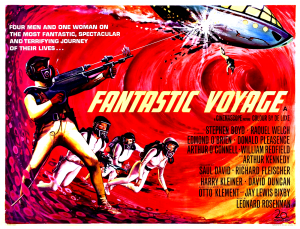“Fantastic Voyage” @ FLMNH (July 19)
The Florida Museum of Natural History’s “Creative B” summer film series features entertaining fantasy and science fiction films and roundtable discussions by scholars, scientists, writers, and artists.
 On July 19, this summer’s series continues with Richard Fleischer’s 1966 science fiction classic Fantastic Voyage.
On July 19, this summer’s series continues with Richard Fleischer’s 1966 science fiction classic Fantastic Voyage.
At the height of the Cold War, both the United States and the Soviet Union have developed technology to miniaturize objects to microscopic scales. A new space race has begun; with this breakthrough, observes an American general, “we can shrink an army – with all its equipment – and put it in a bottle cap.” But the miniaturization effect is limited. Anything that is shrunk will return to its original size after 60 minutes.
Dr. Jan Benes, working behind the Iron Curtain, has learned how to get around this limitation. With the help of American intelligence agents he escapes to the West. But before he can tell anyone the secret of at-will miniaturization and deminiaturization, an assassination attempt leaves him comatose with a blood clot deep in his brain that cannot be removed from the outside. To save Benes’s life, a team of security and medical personnel are placed aboard a Navy submarine, the Proteus, which is miniaturized and injected into his bloodstream. The team has one hour to travel to the clot, destroy it, and get back out of Benes’s body before they begin to revert to their normal size and his immune system attacks them. But someone on board the Proteus has other plans…
Fantastic Voyage has been celebrated for its then state of the art practical and visual effects and seamless integration of miniature and full-size sets. The Proteus was designed by Harper Goff, the designer of the Nautilus for Fleisher’s film of 20,000 Leagues Under the Sea for Walt Disney Productions. Fred Zendar, who had served as technical advisor on that film, performed the same role on Fantastic Voyage. Special effects were supervised by L.B. Abbott, Art Cruickshank, and Emil Kosa, Jr. Filmed in CinemaScope (2:35:1) by legendary Hungarian-American cinematographer Ernest Laszlo, the film won two Academy Awards for Art Direction and Special Effects, and was also nominated for best cinematography, film editing, and sound editing. Strictly speaking a “hard” science fiction film with an emphasis on the technology of miniaturization, the capabilities of the submarine, and the anatomy of the human body, its imagery and action are nonetheless deeply infused with the fantastic. Scenes of the Proteus moving gracefully through Benes’s bloodstream and lymphatic system, and of the miniaturized voyagers in scuba gear, swimming freely inside his brain, are uncanny and unforgettable.
The son of legendary American animator/producer Max Fleischer (creator of Betty Boop), Richard O. Fleischer’s career as a director spanned nearly fifty years and more than fifty films. He is best known for his early film noir thrillers (including The Narrow Margin, 1952) and later big-budget adventure, fantasy, and science fiction films, including 20,000 Leagues Under the Sea (1954), The Vikings (1958), Doctor Dolittle (1967), Tora! Tora! Tora! (1970) and Soylent Green (1973).
Fantastic Voyage was adapted by screenwriter and novelist David Duncan from a story by Otto Klement and science fiction author and television writer Jerome Bixby; the screenplay is by Harry Kleiner. The orchestral score is by composer Leonard Rosenman, and is noteworthy for including no music during the first four reels, before the voyagers enter Benes’s body, then almost entirely atonal music until the film’s climactic ending. Starring are Stephen Boyd (as Agent Grant), Raquel Welch (as Cora Peterson, in her first major role), Edmond O’Brien (as General Carter), Donald Pleasence (as Dr. Michaels), Arthur O’Connell (as Colonel Donald Reid), William Redfield (as Captain Bill Owens), and Arthur Kennedy (as Dr. Peter Duval).
American science fiction master Isaac Asimov wrote a popular 1966 novelization of the film based on the screenplay, and in 1987 a reimagining of the story, Fantastic Voyage II: Destination Brain. Kevin J. Anderson’s 2001 novel Fantastic Voyage: Microcosm was a third published version of the story. Plans for a filmed sequel or remake have been announced over the years, with James Cameron, Paul Greengrass, Shawn Levy, or Guillermo de Toro set to direct.
The evening’s events begin at 7 PM. The screening will be preceded and followed by a roundtable discussion featuring:
- Ian Breheny – Museum Operations Specialist at the FLMNH, co-founder of the film series, and moderator
- Terry Harpold – Associate Professor of English, Film & Media Studies at UF
- Robert Ferl – Distinguished Professor and Assistant Vice President for Research at UF
- Tim Lawrence – Special effects artist and concept sculptor, ILM Creature Shop supervisor for Ghostbusters 2, concept sculptor for Jurassic Park and character FX crew and puppeteer for Gremlins 2 and Harry & the Hendersons
Fantastic Voyage is rated PG for mild violence and language.
On July 26, beginning at 7 PM, the series concludes with Rob Minkoff’s Mr. Peabody & Sherman (2014).
All “Creative B” events are free and open to the public.
Comments are currently closed.